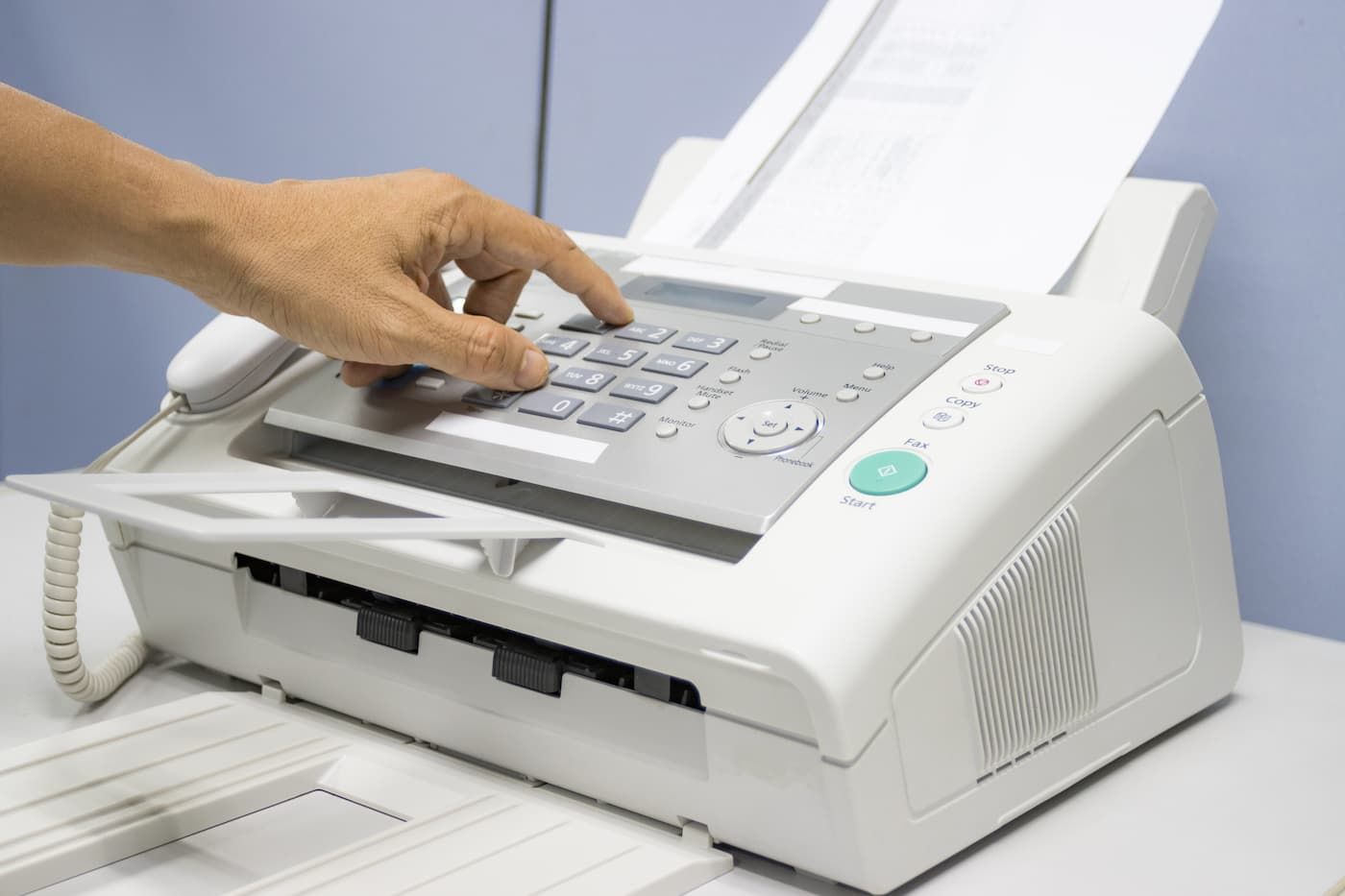A fax analog telephone adapter (ATA) is a device that allows you to use a traditional fax machine to send faxes over an Internet connection. Sometimes called a fax machine adapter, fax connector, or fax bridge, a fax ATA makes it easy to modernize your office communications while still using the equipment you're familiar with and, in some cases, should. use.
In the United States and many other countries, governments have given the green light to telecommunications providers to stop maintaining traditional telephone lines. In other words, landlines are disappearing in favor of more modern technologies, such as fiber optic cable. Once that happens in your area, analog fax machines will not work without an ATA.
I'll explain which traditional fax doesn't work over the Internet, how an ATA fax works, the different types available, and how to choose one that suits your needs.
How an ATA fax works
An ATA fax acts as a translator between two different technologies: the public switched telephone network (PSTN) and the Internet. The fax was designed for telephone lines, which transmit analog signals. The Internet transmits digital data known as packets. The two transmission methods are not compatible.
Let's dive a little deeper into both technologies so you can see how an ATA fax provides the missing link and allows any older fax machine to send digital faxes.
A fax machine works the same way as a telephone: it sends analog signals over telephone lines, but instead of converting voice into a signal, the fax converts an image into signals that can be transmitted.
The fax machine scans any document you feed it, translates the document into an image, and then converts it into audio tones that are sent over telephone lines. People born before the year 2000 will remember the beeps and beeps that a dial-up modem made; those are the audio tones I'm talking about.
Once the audio signal reaches the other side, the receiving fax machine converts those signals back to a visual format and then prints the original image.
While this works fine when you use a telephone line, which is designed to transmit analog signals, things are a little different when you use the Internet, which transmits digital data instead of analog signals.
That's why you can't send a fax from an analog machine over the Internet without a “translator” of some kind; It just doesn't know how to create data packets, so there is nothing for the Internet to send to the other fax machines.
That's where an ATA fax comes into play. It takes the analog signals your fax machine creates from the original visual image and translates them into data packets that can be sent over the Internet. Once the data packets reach the other end, they are translated back into a visual format capable of being printed.
Installing an ATA fax
While fax ATAs can vary a bit from model to model, they typically look like small boxes with three plugs on the back. One is for the power cord and is usually labeled “Power” or sometimes “DC 5V” to indicate the type of power it uses.
Another connector is for the cable that connects the ATA to the fax machine and looks like a normal telephone connector that you would use with a landline. This may be labeled “Fax” or “Phone.” In some cases, there may be more than one, meaning you can connect the device to multiple fax machines at once.
There is another connector that also looks like a traditional landline phone connector (only larger), and this one is used to connect to the Internet. It could be labeled “Internet,” “Ethernet,” or “WAN/LAN.” If it is labeled “Internet”, you can connect it directly to your router. Otherwise, you may have to connect it to your computer, assuming your computer has some type of Ethernet port.
This should work the same no matter what type of port you have. The only difference is whether the ATA connects to the Internet directly or whether it connects to the Internet through your computer as an intermediary.
Since each of these plugs has a different type of cable that just needs to fit into its respective port, it would take a lot of effort to get things wrong; All you have to do is make sure the correct cable is plugged into the correct socket. and you're usually ready to go.
How to select the correct fax ATA
Some fax ATAs will work better for certain use cases and different business sizes. Some of the best analog phone adapters will work for fax machines, telephones, and other legacy landline communication technologies.
If you only need a fax ATA for a home office, you'll probably be fine with a simple single-port ATA that allows you to connect to a fax machine. Look for one that is device-agnostic and uses an open communications protocol, meaning it can work with any type of fax machine and any type of computer.
Most small businesses can also get away with using a single ATA port, unless they send and receive a lot of faxes and need to be able to operate multiple fax machines at once.
If this is the case for you, choosing a multiport fax adapter that allows you to connect to multiple fax machines may be a good idea, and you may want to consider one that connects to phones and fax machines at the same time. If you want to move your communications to Voice over Internet Protocol (VoIP) but still want to use your analog landline and fax machine, this could be a good option.
DOWNLOAD this TechRepublic Premium VoIP Solutions Feature Comparison
For large organizations and those running a unified communications environment with Session Initiation Protocol (SIP) trunking, an advanced solution may be the smartest choice.
In this case, you'll want to look for a system that offers ATA fax capabilities while also allowing you to make phone calls over the Internet. This is similar to how a traditional landline PBX works, but instead of using the PSTN, it uses the Internet.
These devices do everything an ATA fax does, plus they allow you to connect multiple traditional landlines to the Internet for VoIP calls. If you have a modern VoIP phone system, this opens the door to a number of useful call management features, including call forwarding, call waiting, and advanced security protocols.
Fax ATA Codec Options
Broadly speaking, codecs are software algorithms used to compress, encode, and decode audio signals for transmission over digital networks. For fax transmission, codecs must handle image data rather than just voice.
This is where the aforementioned “translation” process comes into play. Fax ATA can convert the audio tones generated by your fax machine into digital data that can be sent over the Internet.
There are several fax codecs, the three most common being T.30, T.38 and G711, which is also a very popular VoIP codec. Let's go over each codec and when it makes sense to use it.
- T.30 It is designed to be used over an analog telephone line and works well if you send faxes the traditional way. It won't work for VoIP faxing unless you have an ATA that can translate the signals in such a way that they support a T.38 protocol.
- T.38 It is perhaps the most widely used fax codec and is recognized by most machines. It generally has very low bandwidth, can handle latency delays of up to one second, and has security devices to prevent packet loss. However, given the type of signal that T.38 creates and how it travels over the PSTN, you can sometimes have problems with the quality of your fax.
- G.711 It is similar to T.38, but uses much more bandwidth because it converts its signals into audio packets. This works with most machines, but has much more packet loss potential than T.38.
The simple alternative to using an ATA fax
One way to avoid using a fax ATA is to switch to an online fax service. You may have to purchase a fax ATA if you're set on using a fax machine or multifunction printer, but with online fax services, you don't need those machines at all.
With these services, people can send and receive faxes from their email, phone, tablet, laptop; Virtually any device that is connected to the Internet will work. The provider is responsible for maintaining all the infrastructure necessary to send/receive faxes, so whenever you log in to the service, you will be ready to send faxes.
For individuals, there are lightweight apps that will allow you to send a fax from your iPhone, as well as free online fax services that you can access through your browser. Free fax options are great if you rarely need to send faxes. Paid options are much better if you need to store, label, and retrieve faxes later.
For businesses, the main consideration when switching to online fax is compliance. Any reputable online business fax service will be safe, but may not meet privacy and security standards.
For example, not all fax services are HIPAA compliant. Some providers may not offer all required features, and some that do are not yet willing to sign a Business Partner Agreement, making the service non-compliant.
So if your company has compliance responsibilities beyond the standard, it's definitely a good idea to ensure that any online fax software you select meets all required standards for data encryption, access control, etc.
The transition to online fax will not be a choice forever. In the United States, the landline infrastructure is about to disappear. The Federal Communications Commission (FCC) has said that phone providers do not have to maintain old PSTN lines as long as they offer a viable alternative.
The phase-out is already happening. An ATA will allow you to continue using your fax machines and landline devices as normal, regardless of when landlines are removed in your area.












